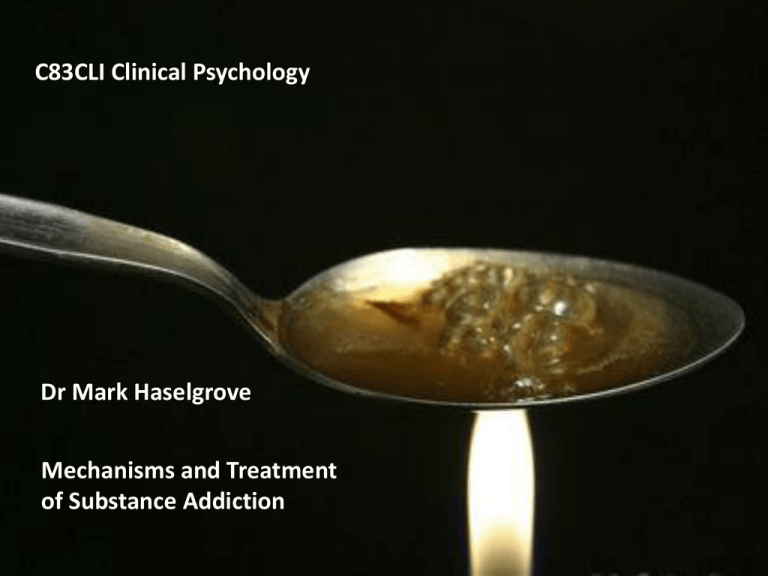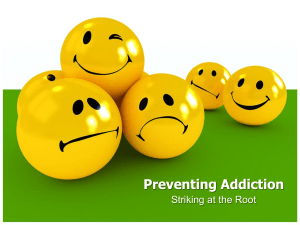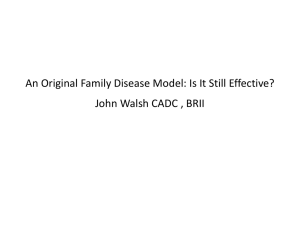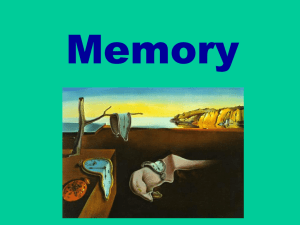Substance Addiction
advertisement

C83CLI Clinical Psychology Dr Mark Haselgrove Mechanisms and Treatment of Substance Addiction Overview of the Lecture Part A: Mechanisms of Substance addiction What effects of drugs motivate their use? Conditioning analysis of substance addiction (i) Drug cues elicit CRs in users and non-users (ii) Tolerance is a diminution of the UR - evidence Part B: Treatment of Substance addiction Extinction of conditioning to alcohol cues Cue Exposure (i) Four Examples (ii) Meta Analysis (iii) Why doesn’t it work (so well) – the four Rs Renewal (i) Extinction of cue-alcohol learning in rats (ii) Extinction of cue-alcohol learning in humans What to do about all of this? Multi context cue-exposure therapy (B) Mechanisms of Substance addiction. What effects of drugs motivate their use? O-Brien, Ehrman & Ternes (1986) Addictive Phase Initial Phase - 1 day to years - Intermittent use - Incentive motivation Early Late Methadone Post-Methadone -Daily use. - Periods of selfdetox. Again, primarily incentive motivation - Continuous use. - Increasing tolerance. - Concerns about withdrawal. - Less importance of incentive motivation -Little fear of withdrawal. -Drug use based on desire for euphoria. - Non-drug reinforcement can be acquired -Drug free. - If relapse occurs new period in addictive phase is brief. Then rapid transition to late addictive phase Phenomena to be explained: Tolerance: Adaptation to repeated exposure to drug. Effects of given dose of drug ↓. Relative to first exposure Dependence: Often accompanying tolerance. Presence of drug required for normal functioning. Absence of drug → craving, withdrawal symptoms Relapse: Resuming drug use after periods of non-use (B) Mechanisms of Substance addiction. What effects of drugs motivate their use? O-Brien, Ehrman & Ternes (1986) Examples of stimuli that elicit craving/withdrawal symptoms in former heroin addicts: Bag of heroin Enough cash to buy heroin Person shooting up, being high Sight of dealer Movie about junkies talking about drugs Also: anecdotal evidence that craving and relapse ↑ if user is in environment where drug use was acquired Conditioning (associative) Analysis (Siegel, 1983; 2005) CR Drug cues (CS) (At least) Two things should happen: Drug (US) (1) Drug cues evoke CR (2) Effectiveness of the US diminishes when expected (Rescorla & Wagner, 1972) (B) Mechanisms of Substance addiction. PREDICTION 1. CR to DRUG CUES Foltin & Haney (2000) CR to drug cues in cocaine users 8 cocaine smokers (30-41 yrs old). Used drug 3-7 days a week (1-4 g smoked each binge) Two different stimuli established CS+ → Cocaine, CS- → Placebo (e.g different smells/visual stimuli). CSs presented for 2 min, then drug (or placebo) smoked (blindfolded & behind a screen) Study lasted 15 days, repeated training (CS+, CS-) trials, and intermixed test days. No control group though (thus don’t know if the effect is specific to addicts) But Ehrman et al (1992) showed CR effects specific to cocaine users. No effect in drug naive group. Monti, Rohsenow et al (1993). alcohol abusers urge to drink, salivation to a favourite drink (cf’d to H2O was unchanged despite a month of detox) (B) Mechanisms of Substance addiction. PREDICTION 1. CR to DRUG CUES Perhaps addicts are just easier to condition to drug cues Better to demonstrate a similar effect in non-addicts - before dependency has been acquired Glautier, Drummond & Remington (1994) - 12 male volunteers – none with a history of drinking problems - Two colour/flavour compounds (red peppermint/ blue angostura) mixed with drinks CS+ contained alcohol, CS- did not. - Each day, for 8 days, look at then sip either the CS+ or CS-. Then consume whole drink in 10 min. (B) Mechanisms of Substance addiction. PREDICTION 2. Tolerance to Drug when it is cued (US effectiveness ↓) Siegel et al. (1983) Acquisition of a cue-specific tolerance (and overdose) in rats Three groups of rats given following training: ST IV Heroin (up to 8mg /kg) in Room A. IV Dextrose in Room B DT IV Dextrose in Room A. IV Heroin (up to 8mg /kg)in Room B Control Dextrose in Room A and Room B Then, a test: All groups given 15mg/kg Heroin in ROOM A Experiment run in 6 replications. Mortality DT>ST every time. Cue specific tolerance Non-specific tolerance (Habituation?) (B) Mechanisms of Substance addiction. PREDICTION 2. Tolerance to Drug when it is cued (US effectiveness ↓) Siegel & Ellsworth (1986) Case study of cue-dependent tolerance & overdose in human. Pancreatic cancer patient. Attended to at home (by son N. E.). 4 x morphine injections/day for 4 weeks Comparable reports by heroin overdose victims (Siegel, 1984) Interesting, but...multiple shortcomings. E.g.: (obviously) anecdotal. Non-controlled (he may have died if injected in bedroom) (B) Treatment of Substance addiction. Theoretical Background If substance addiction = conditioning, then we can do something about this. CR CS US Chaudhri et al. (2008) Stage 1: CS+ → 0.2 ml of 10% Alcohol CS- → nothing Stage 2: CS+ → nothing CS- → nothing Session Presentation of drug associated cues in the absence of the drug, should weaken CR (B) Treatment of Substance addiction. Cue exposure Therapy Repeated presentations of drug associated cues (CSs) e.g. sight, smell of alcohol/cigarettes IN THE ABSENCE OF THE DRUG (US) Raw & Russell (1980) 33 Heavy smokers (≈35 cigs/day) 20 Male, 29 female. Assigned to 1 of 2 groups and received 3 weeks of treatment. Each session 45 min/day: Simple support: Record keeping, support, encouragement and praise from therapist for abstinence. ss told to avoid smoking cues (e.g. smoking area on bus) Cue exposure: As above, but ss encouraged to confront cues. In sessions, client asked to light up and hold cig (not smoke) also drink coffee. Therapist smoked, and offered cigs. (B) Treatment of Substance addiction. Cue exposure Therapy Raw & Russell (1980) Cont... - Simple support and cue exposure reduced cig consumption - Cue exposure no better than support - Neither treatment prevented relapse - R&R suggest failure of both treatments → Very heavy smokers ( twice the then national average) - Perhaps CS-US association particularly strong in this sample – 3 weeks of extinction not enough to counter this? - This absence of effect replicated (Niaura etal , 1999). Not all addictions equally suited to cue exposure. (B) Treatment of Substance addiction. Cue exposure Therapy McLellan et al (1986) Conditioned withdrawal Wikler (1948) Former opiate addicts report withdrawal symptoms/craving upon exposure to stimuli associated with the drug → relapse Pilot study – Clients asked to “cook up” heroin, but then inject saline. - At first, clients reported injecting was pleasurable - After repeated injections, it became aversive (elicited withdrawal symptoms). Drop out ↑ Graduated Extinction – Hierarchy of CS extinguished in turn, building up a tolerance to “cooking up”, and injecting. Sessions also followed with relaxation training (a la systematic desensitization; Wolpe, 1958) (B) Treatment of Substance addiction. Cue exposure Therapy McLellan et al (1986) Cont... 56 outpatient methodone treatment volunteers. Personality Q and structured interviews assessed addiction severity. Also measured co-morbid metal health problems (e.g. psychosis) Randomly assigned into 1 of 3 groups: Experimental: CBT + Graduate Extinction + relaxation Control 1: CBT + Relaxation Control 2: Simple support/ counselling Session = 30 min CBT, 15 min extinction, 15 min relax 3 x week. 35 in total (B) Treatment of Substance addiction. Cue exposure Therapy McLellan et al (1986) Cont... (B) Treatment of Substance addiction. Cue exposure Therapy O’Brian et al (1990) 30 drug-free former cocaine addicts (23-53 ys old). ≈3 years of drug use. Clean for 7-10 days Baseline assessment: Responsively to cocaine related stimuli. Physiological measures (temp, HR, GSR). Self report Q (subjective high, craving, withdrawal etc) Randomly assigned into 1 of 4 groups: SE-X: Supportive-Expressive Psychotherapy + Extinction SE-C: Supportive-Expressive Psychotherapy + Control activities DC-X: Drug counselling + Extinction DC-C: Drug counselling + Control activities Extinction (each session): 3 x 5min drug videos 3 x 5 drug audios 3 x cocaine rituals 15 x 1 hour sessions over two weeks (B) Treatment of Substance addiction. Cue exposure Therapy O’Brian et al (1990) Data from Extinction groups... Little data presented from control groups. Qualitative reports: - Much lower drop out rate in extinction groups (8 week program, ex grps lasted 6.5 and 7 weeks, controls, 1 week & 3.5 weeks). - Urine metabolites revealed ex groups had more weeks with clean samples than control groups (no stats here though). (B) Treatment of Substance addiction. Cue exposure Therapy Drummond & Glautier (1994) 108 male patients referred from hospital alcohol clinic. 63 dropped because of mental/physical health complications, or insufficiently severe alcohol dependence. Final N = 45 Clients assigned into 1 of 2 groups: CE (Cue exposure): Exposed to alcohol stimuli (handling drink, smell) for 40 min/day 10 consecutive weekdays. 1st 5 days - ↑ salience alcohol drink 2nd 5 days ↓ salience drink) RC (Relaxation control): Progressive relaxation training in replacement of CE Level 1= Level 2= Level 3= Level 4= Level 5= Btw 0-10 units alcohol Btw 11-20 units alcohol Btw 21-30 units alcohol Btw 31-40 units alcohol Btw 41-50 units alcohol on 3 days consecutive (B) Treatment of Substance addiction. Cue exposure Therapy Conklin & Tiffany (2002) – Conducted a meta analysis 18 non-case study cue exposure treatment studies 9 met criteria for meta analysis: (i) The study included a control (or comparison treatment) group (ii) Post treatment follow up was included. + = CE > cntrl -= CE < cntrl Cohen (1992): Small ≈ 0.2-0.3 Medium ≈ 0.5 Large > 0.8 Overall effect size d = 0.08, n/s Q(9) = 16.07, p=.04 (indicates the effect size was not consistent across studies) (B) Treatment of Substance addiction. Cue exposure Therapy Why is cue exposure so unreliable? Extinction works so well! The Four Rs (Bouton et al, in Haselgrove & Hogarth, 2012) (B) Treatment of Substance addiction. Renewal Chaudhri et al. (2008) Stage 1: CS+ → 0.2 ml of 10% Alcohol CS- → nothing Stage 2: Renewal Test: CS+ → nothing CS- → nothing CS+ → nothing CS- → nothing (B) Treatment of Substance addiction. Renewal Collins & Brandon (2002) Renewal to alcohol cues in humans Assumes participants have (already established) sight/smell of beer → beer association 293 students agreed to volunteer in a beer drinking study. 112 met criteria after screening (Criteria = drank at least 1 or 2 times a week, and sessions > 3 to 4 cans of beer). Final N (after drop outs) = 78. Assigned to 1 of three groups: Extinction: sight and smell of beer (but no opportunity to drink) Context = different rooms (B) Treatment of Substance addiction. Renewal Collins & Brandon (2002) Renewal to alcohol cues in humans Testing in a different context: (1) More drooling (2) Greater urge to drink Implications for treatment: Cue exposure in same context as addiction acquired Less successful attempts at replication: Stasiewicz et al. (2007) [alcoholics]; MacKillop & Lisman (2008) - Important to be sure the contexts are v different otherwise renewal will be weakened (B) Treatment of Substance addiction. Renewal So what can be done about this? Back to Chaudhri et al. (2008) Extinction in multiple contexts attenuates renewal of cue-alcohol association Stage 1: CS+ → 0.2 ml of 10% Alcohol CS- → nothing Stage 2: Renewal Test: CS+ → nothing CS- → nothing CS+ → nothing CS- → nothing Implications for treatment Cue exposure in a variety of locations (e.g. clinic, home, work, pub, etc…) Thank you... (1) Pdfs on moodle and my webpage. (2) My book (Ch 4: vulnerabilities to dependence) (Ch 5: Relapse, extinction & renewal) (3) Questions via moodle, or: Mark.Haselgrove@nottingham.ac.uk Room C9 (Psychology Building)







